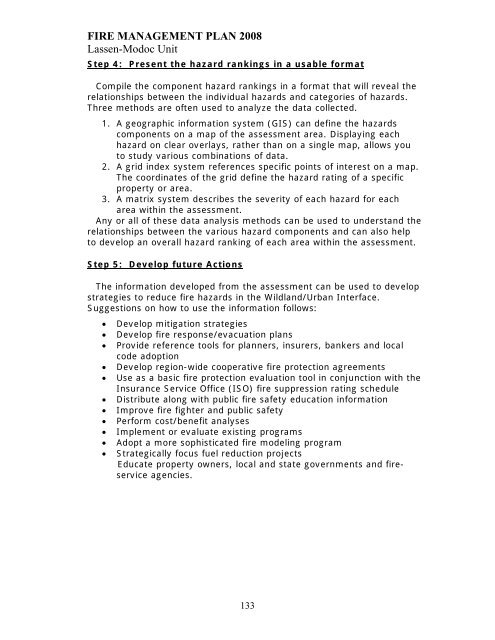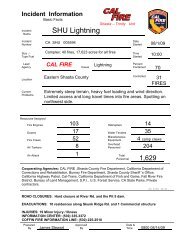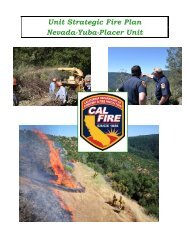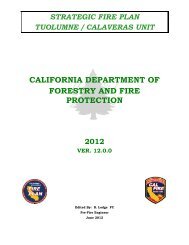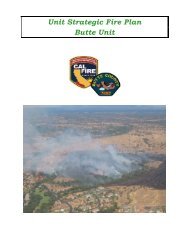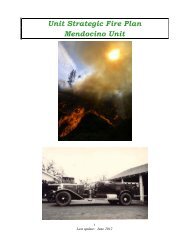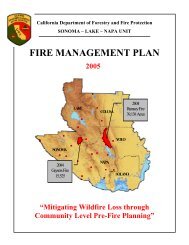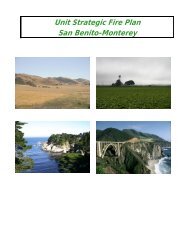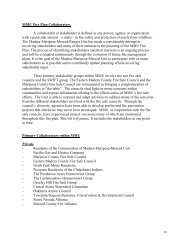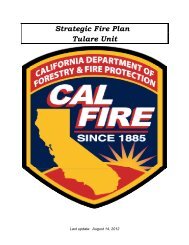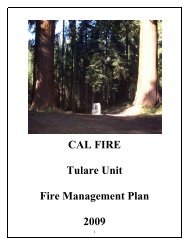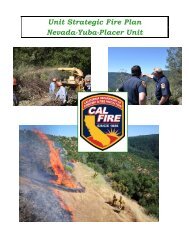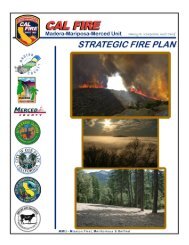Lassen – Modoc Unit - Board of Forestry and Fire Protection - State ...
Lassen – Modoc Unit - Board of Forestry and Fire Protection - State ...
Lassen – Modoc Unit - Board of Forestry and Fire Protection - State ...
You also want an ePaper? Increase the reach of your titles
YUMPU automatically turns print PDFs into web optimized ePapers that Google loves.
FIRE MANAGEMENT PLAN 2008<br />
<strong>Lassen</strong>-<strong>Modoc</strong> <strong>Unit</strong><br />
Step 4: Present the hazard rankings in a usable format<br />
Compile the component hazard rankings in a format that will reveal the<br />
relationships between the individual hazards <strong>and</strong> categories <strong>of</strong> hazards.<br />
Three methods are <strong>of</strong>ten used to analyze the data collected.<br />
1. A geographic information system (GIS) can define the hazards<br />
components on a map <strong>of</strong> the assessment area. Displaying each<br />
hazard on clear overlays, rather than on a single map, allows you<br />
to study various combinations <strong>of</strong> data.<br />
2. A grid index system references specific points <strong>of</strong> interest on a map.<br />
The coordinates <strong>of</strong> the grid define the hazard rating <strong>of</strong> a specific<br />
property or area.<br />
3. A matrix system describes the severity <strong>of</strong> each hazard for each<br />
area within the assessment.<br />
Any or all <strong>of</strong> these data analysis methods can be used to underst<strong>and</strong> the<br />
relationships between the various hazard components <strong>and</strong> can also help<br />
to develop an overall hazard ranking <strong>of</strong> each area within the assessment.<br />
Step 5: Develop future Actions<br />
The information developed from the assessment can be used to develop<br />
strategies to reduce fire hazards in the Wildl<strong>and</strong>/Urban Interface.<br />
Suggestions on how to use the information follows:<br />
Develop mitigation strategies<br />
Develop fire response/evacuation plans<br />
Provide reference tools for planners, insurers, bankers <strong>and</strong> local<br />
code adoption<br />
Develop region-wide cooperative fire protection agreements<br />
Use as a basic fire protection evaluation tool in conjunction with the<br />
Insurance Service Office (ISO) fire suppression rating schedule<br />
Distribute along with public fire safety education information<br />
Improve fire fighter <strong>and</strong> public safety<br />
Perform cost/benefit analyses<br />
Implement or evaluate existing programs<br />
Adopt a more sophisticated fire modeling program<br />
Strategically focus fuel reduction projects<br />
Educate property owners, local <strong>and</strong> state governments <strong>and</strong> fireservice<br />
agencies.<br />
133


